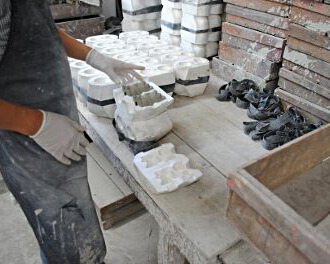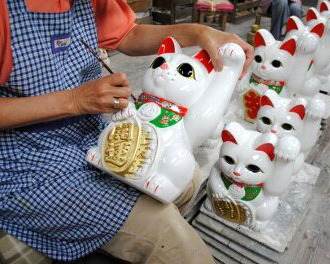Worldwide Shipping! Secure payment
No products
Product successfully added to your shopping cart
There are 0 items in your cart. There is 1 item in your cart.
Maneki Neko
There are 39 products.A Manekineko, also called 'lucky cat' or 'good fortune cat' in Western countries, is a bobtail statue traditionally made of ceramic in Japan.
You can meet them very often in restaurants and shops and also in Japanese homes as a welcoming decoration.
Their origin is uncertain but they seem to have appeared during Edo period (1600-1868).
All our Mane...
A Manekineko, also called 'lucky cat' or 'good fortune cat' in Western countries, is a bobtail statue traditionally made of ceramic in Japan.
You can meet them very often in restaurants and shops and also in Japanese homes as a welcoming decoration.
Their origin is uncertain but they seem to have appeared during Edo period (1600-1868).
All our Maneki Neko are made and hand painted with great care in Japan, near Nagoya city.
Which paw?
In Japan, models waving with the right paw are traditionally supposed to bring money and luck and those waving with the left paw are supposed to bring people or customers.
What color?
The original model is the tricolor one (white with spots) who represents the Japanese bobtail in its most common color.
There are also other versions such as the black Maneki Neko whose function is to repel evil spirits and bad luck and the gold one which suppose to bring wealth to its owner.
Traditional models usually wear a necklace with a bell and a koban (a gold coin from Edo period). The inscription on the coin means ten million ryo (another currency of the same period).
Origins
There are many legends describing the origin of those statues. According to some sources they might come from the Osaka region, while others say they come from Edo (old Tokyo). Today many of the ceramic models are made in Seto and Tokoname.
The most famous story describes how an old woman with no money and out of desperation was forced to sell her cat. Shortly after, one night, she had a dream in which her former companion appeared and asked her to make a statue of him. Troubled by this experience she followed the advice and made a representation of her cat in clay. Soon after, someone came by and offered to buy her statue. She then made a few other ones and again it was an immediate success. She kept doing and it worked so well that she quickly became very rich.
Another story describes how an emperor avoided a trap set by his opponents thanks to a cat beckoning with his paw. Attracted by the amazing attitude of the animal, he went away from his original road and was saved from death. This story is one that is presented as an explanation for the original gesture of these lucky charms.
Manufacturing




The statues are first shaped using molds and then dried for a week or more depending on the conditions (temperature, humidity...) and the size of the objects.
They are then placed in a large oven in which the ceramic will harden and get its final finish. Usually the oven starts only when it is full.
The Maneki Neko are then polished and hand-painted.
Golden models go through a second baking step which stabilizes the color. Because of this second cooking process they are slightly smaller than the other ones.
We assure you the best wrapping and packing for your fragile items. Do not hesitate to contact us if you have any question.
LessRed Cushion
Size: 12.5 x 12.5cm (4.9 x 4.9inches) / 16.5 x 18cm (6.3 x 7.1inches)Thickness: 1 cmMade in Japan
¥1,200Maneki Family Shiawase
Dimensions: 4.1 × 3.3 × 2 in (10,5 × 8,5 × 5 cm)Red carpet: 4.2 × 3.1 in (10,6 × 8 cm)Material: CeramicMade in Japan
¥3,200Shiro Koban Migite
Height: 23cm (9in) / 19cm (7.5in) / 16cm (6.3in) Maneki Neko made and hand-painted in Tokoname, Japan
¥3,800Kogane Koban
Height : 15cm (5,9in) or 18cm (7,1in)Cushion not included, on sale hereManeki Neko made of ceramic and hand-painted in Tokoname, Japan
¥6,500Daruma Koban
Height: 19cm (7.5in)Maneki Neko made of ceramic and hand-painted in Tokoname, Japan
¥8,000Shiro Koban Hidarite
Height: 23cm (9in) / 19cm (7.5in) / 16cm (6.3in)Made of ceramicManeki Neko made and hand-painted in Tokoname, Japan
¥3,800Kuro Koban Migite
Height: 19cm (7.5in) / 16cm (6.3in)Maneki Neko made and hand-painted in Tokoname, Japan
¥4,900Kuro Koban Hidarite
A0509-01-0004Height: 19cm (7.5in) / 16cm (6.3in) Maneki Neko made and hand-painted in Tokoname, Japan
¥4,900Ojigi
A0509-01-0006Height: 25cm (9.8in) Maneki Neko made and hand-painted in Tokoname, Japan
¥9,900Gamagucci Neko
Dimensions: 19,5 cm (width) x 16 cm (depth) x 21 cm (height) (7.7in x 6.2in x 8.3in) Made by the craftmen in Shibaraki, Japan.
¥7,500Maneki Neko Sake Set
Dimensions: Bottle: 8 × 8.5 × 10 cm (270 ml) / 3.15in × 3.35in × 3.94in Cups: Ø 6.2 × 3.5 cm / Ø2.44in × 1.38in Material: Mino porcelain Made and hand-painted in Japan, in Gifu Prefecture
¥3,400Maneki Neko Bowl
v19-tg-44247-339Dimensions (big version): ø14.2cm x 6.3cm / ø5.6in x 2.5in Bowl made in Mino, Japan
¥1,200Warashi Neko
Dimensions:11cm x 13.5cm x 12.5cm4.3in x 5.3in x 4.9inAroma Burner made in Tokoname, Japan
¥4,400Kao Neko
Dimensions : 15cm x 11.2cm x H6.1cm / 5,9in x 4.4in x H2.4in Capacity : 500ml / 16.9oz Fabrication: ABSThe inside compartments: Polypropylene Microwave and dishwasher safe with lid removed Made in Japan
¥2,400Noren Jyoumon Raifuku
A0801-12-0030Dimensions: 85cm x 150cm (33.5in x 59.1in) Material: 100% polyester Made in Japan
¥2,900Noren Shichi Fuku Neko
Dimensions: Largeur : 85cmHauteur : 30cm (11,8in)/ 90cm (35,4in) / 150cm (59in) Materials: 30cm versions : 100% cotton90cm yellow version : 100% cotton90cm blue version : 100% polyester150cm versions : 100% polyester Made in Japan
¥1,900Noren Kaiun Shoufuku Neko
Dimensions: 85cm x 150cm (33.5in x 59.1in)There is in the center a narrow seam where the noren could be cut with the desired height. Material: 100% polyester Made in Japan
¥2,900Maneki Neko & Kokeshi Erasers Iwako
Size : Maneki Neko - 3.3 cm (1.3inch) / Kokeshi - 4.2 cm (1.7inch) Unsuitable for children under 3 yearsNo toxic substancesMade in Japan
¥400Maneki Neko Iwako Eraser
Size : 3.3 cm (1.3inch)Unsuitable for children under 3 yearsNo toxic substancesMade in Japan
¥80Kuro Maneki Neko Bento
Dimensions : 14.8cm x 11cm x H6.8cm / 5,8in x 4.3in x 2.7inCapacity: 520ml / 17.6oz Material: ABSInner lid: PolyetyleneMini fork: Stainless steel Not suitable for microwave and dishwasher. Made in Japan
¥2,200Shiro Maneki Neko Bento
Dimensions : 14.8cm x 11cm x H6.8cm / 5,8in x 4.3in x H2.6inCapacity: 520ml / 17.6oz Fabrication: ABSInner lid: PolyetyleneMini fork: Stainless steel Not suitable for microwave and dishwasher Made in Japan
¥2,200Maneki & Daruma Stickers
Stickers sheet size : 90 mm x 200 mm / 3.5in x 7.87inAverage width of stickers: 15mm / 0.6inMade in Japan
¥270Furoshiki Maneki Neko Naru
Size: 50 x 50 cm (19.7 x 19.7in)Material : 100 % cottonMade in Japan
¥950Animals Plants Peropon
Dimensions: 7,6cm (height) x 7cm (width) x 10,5cm (depth) (2.9 in x 2.7 in x 4.1)Material: ceramicMade in Japan
¥2,700Noren Irashaimase Maneki Neko
Dimensions: 90 cm x 83 cm (35,4in x 32,6in)Material: 100% cottonMade in Japan
¥3,800Noren Ookii Maneki Neko
Dimensions: 90cm x 83cm (35,4in x 32,6in)Material: 100% cottonMade in Japan
¥3,800Neko Daruma Chopsticks Holder
Dimensions: H4cm x 4,5cm (H1,5in x 1,8in)Ceramic chopsticks holder made in Japan
¥620Furoshiki Maneki Neko Shogatsu
Size: 50 x 50 cm (19,7 x 19,7in)Material: 100% cottonMade in Japan
¥950Furoshiki Fuku Maneki Neko
Size and material: - 50 x 50cm (19.7 x 19.7 in) 100% cottonor- 68cm x 68cm (26.7 x 26.7 in) 100% rayon (artificial silk)Made in Japan
¥950Kokeshi Shiro Maneki Neko
Dimensions: ø10cm x 13cm / ø3.9in x 5.1in or ø11,5cm × 16cm / ø4.5in x 6.3in Volume: 440ml / 14.8oz or 850ml / 28.7ozUpper compartment: 240ml / 8.1oz or 500 ml / 17ozLower compartment: 200ml / 6.8oz or 350 ml /12ozBowl: 240ml / 8.1oz or 350 ml / 12oz Fabrication: ABS, inner lid in PolyesterCan be used in microwave except the inner lid...
¥2,400Kokeshi Kuro Maneki Neko Bento
Dimensions: ø10cm x 13cm / ø3.9in x 5.1in or ø11,5cm × 16cm / ø4.5in x 6.3in Volume: 440ml / 14.8oz or 850ml / 28.7ozUpper compartment: 240ml / 8.1oz or 500 ml / 17ozLower compartment: 200ml / 6.8oz or 350 ml /12ozBowl: 240ml / 8.1oz or 350 ml / 12oz Fabrication: ABS, inner lid in PolyesterCan be used in microwave except the inner lid...
¥2,400PERSONAL SHOPPER SERVICE
The Tokyo Smart team is available to help you find all the Japanese products you are looking for. Please contact us via the contact form and describe the products you are looking for with the most details possible.

